
Introduction
Where there are guilds, there is a community; where there is a community, there is jargon. Jargon refers to the specialized vocabulary and technical terms that arise within specific organizations or professions due to unique living and working environments. The study of jargon has always been an important pathway to understanding specialized guilds.
The battery industry, being a long supply chain with high technological maturity, has also produced many interesting industry jargons. Previously, the Battery Trading Network summarized a set of these terms. After reading it, did your understanding of the battery industry deepen? In this issue, we have compiled 10 common professional terms from the battery industry to help everyone gain a more comprehensive understanding of the battery industry ecosystem.
Jargon Entries
To help everyone better understand the professional terms in the battery industry, the Battery Trading Network has compiled these “jargons” into a table, with a total of 10 entries in this second issue.
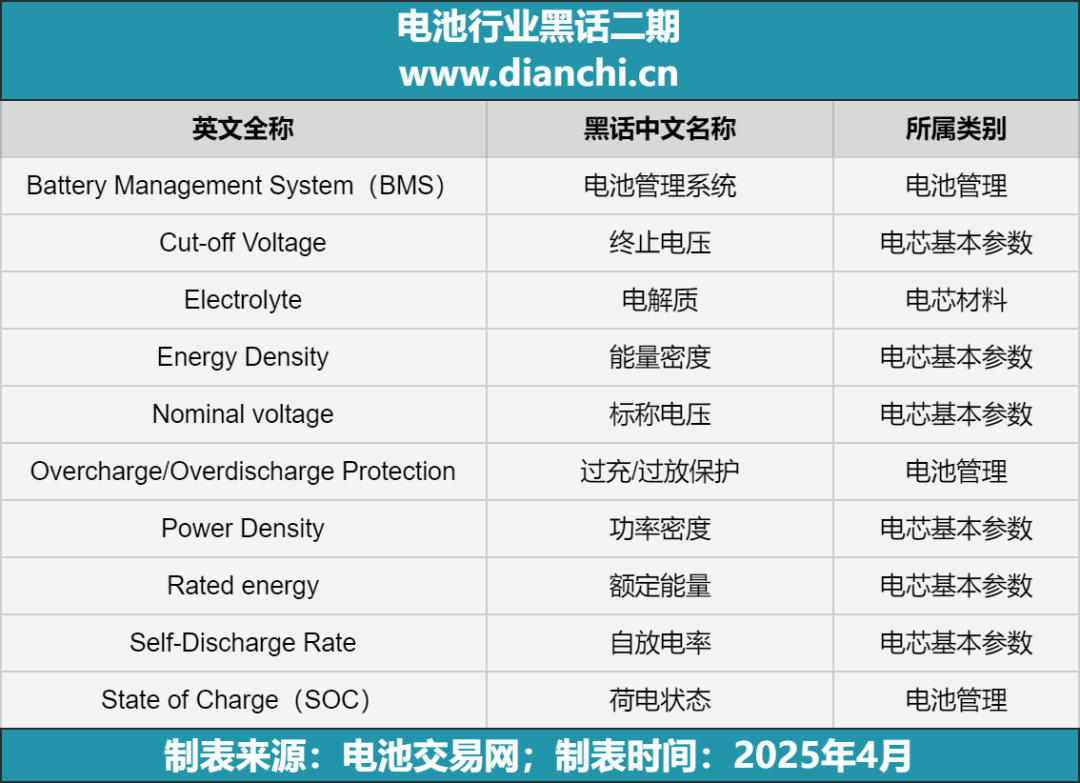
The compiled jargon entries are divided into four categories: Battery Management, Cell Basic Parameters, Standards and Specifications, and Cell Materials. Currently, the main focus is on the basic parameters of the cell, with a total of 6 items. These parameters allow for a quick understanding of the core performance of the cell.
We have organized the 10 new jargon entries in alphabetical order for your reference, with no ranking implied.
B
BMS
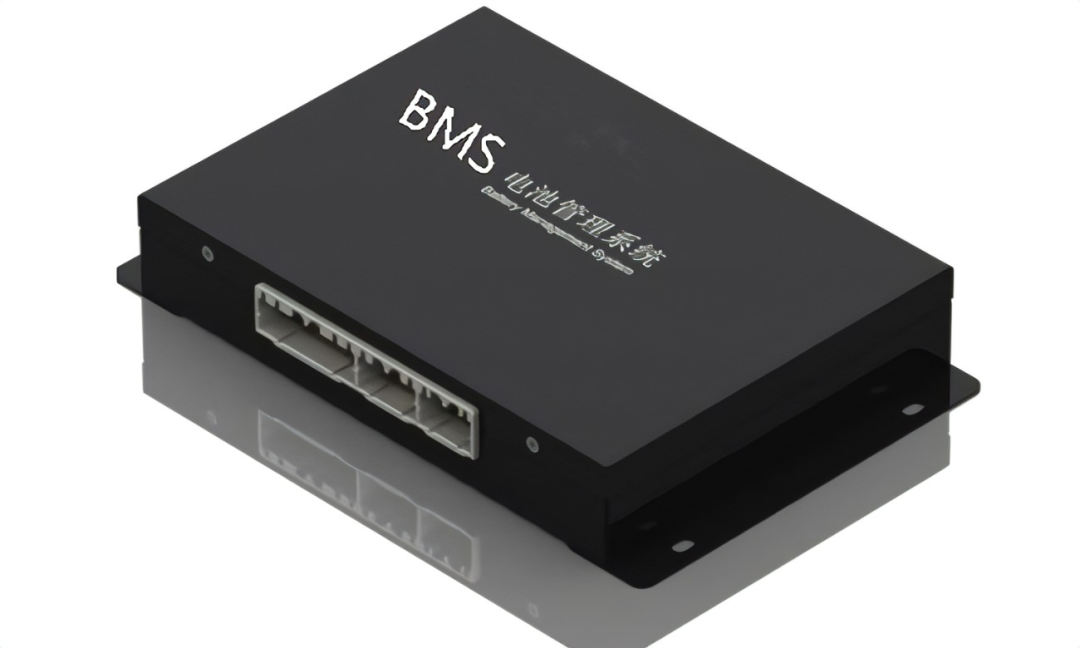
BMS (Battery Management System) is like the “smart steward” of the battery, monitoring parameters such as battery voltage, current, and temperature in real-time, controlling the charging and discharging process, balancing the voltage of individual battery cells, and implementing overcharge and overdischarge protection functions. It comprehensively protects the battery, ensuring safer, more efficient, and longer-lasting operation, making it an indispensable “behind-the-scenes hero” of modern battery systems.
C
Cut-off Voltage

Cut-off Voltage is the limit voltage at which charging or discharging must stop to ensure the safety and performance of the battery. If the discharge cut-off voltage is too low, excessive discharge can damage the internal structure; if the charging cut-off voltage is too high, it may lead to electrolyte decomposition, battery swelling, and other dangers. It serves as the “warning line” for the safe operation of the battery.
E
Energy Density
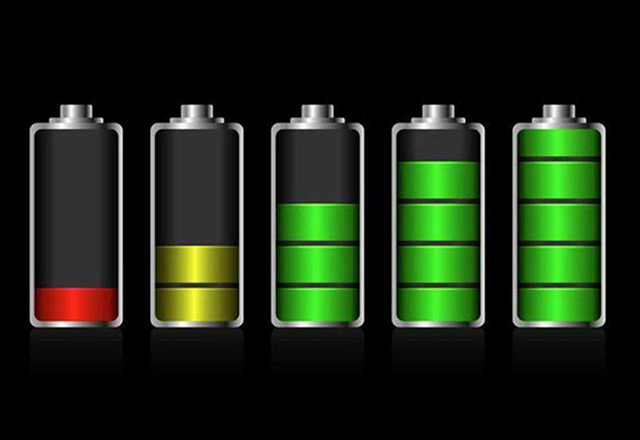
Energy Density indicates the amount of energy that a battery can store per unit mass or volume, measured in Wh/kg or Wh/L. It determines the balance between the battery’s “size” and its endurance. For example, in electric vehicles, pursuing high energy density batteries allows for longer driving distances without significantly increasing vehicle weight or occupying too much space, akin to equipping a car with an “energy compression pack” to efficiently utilize every inch of space and every gram of weight to store electrical energy.
Electrolyte
Electrolyte is the key material in a battery that conducts ions, allowing ions to move between the positive and negative electrodes to complete the electrochemical reaction. The performance of the electrolyte directly affects the battery’s charging and discharging efficiency, cycle life, safety, and operating temperature range.

Electrolytes typically consist of electrolyte salts, solvents, and additives. Common types of electrolytes include liquid electrolytes, solid electrolytes, and polymer electrolytes. Liquid electrolytes have good ionic conductivity but pose risks of leakage and combustion; solid electrolytes offer higher safety and mechanical stability but have relatively poor ionic conductivity; polymer electrolytes combine the advantages of both, providing good flexibility and certain safety. In lithium-ion batteries, the commonly used electrolyte salt is lithium hexafluorophosphate (LiPF₆), and the solvent is usually organic carbonate compounds such as ethylene carbonate (EC), dimethyl carbonate (DMC), and diethyl carbonate (DEC). These components work together to ensure smooth ion migration during the charging and discharging processes.
The selection and optimization of electrolytes are crucial for enhancing battery performance. A good electrolyte should possess high ionic conductivity, chemical stability, thermal stability, and safety, while also being compatible with other components of the battery (such as electrode materials). With the advancement of battery technology, research and application of new electrolyte materials are continuously progressing, aiming to improve battery energy density, cycle life, and safety to meet the growing energy storage demands.
N
Nominal Voltage
Nominal Voltage is the standard voltage value specified for a battery during normal operation, serving as a simplified representation of the battery voltage, providing reference for users and engineers when designing and using circuits.
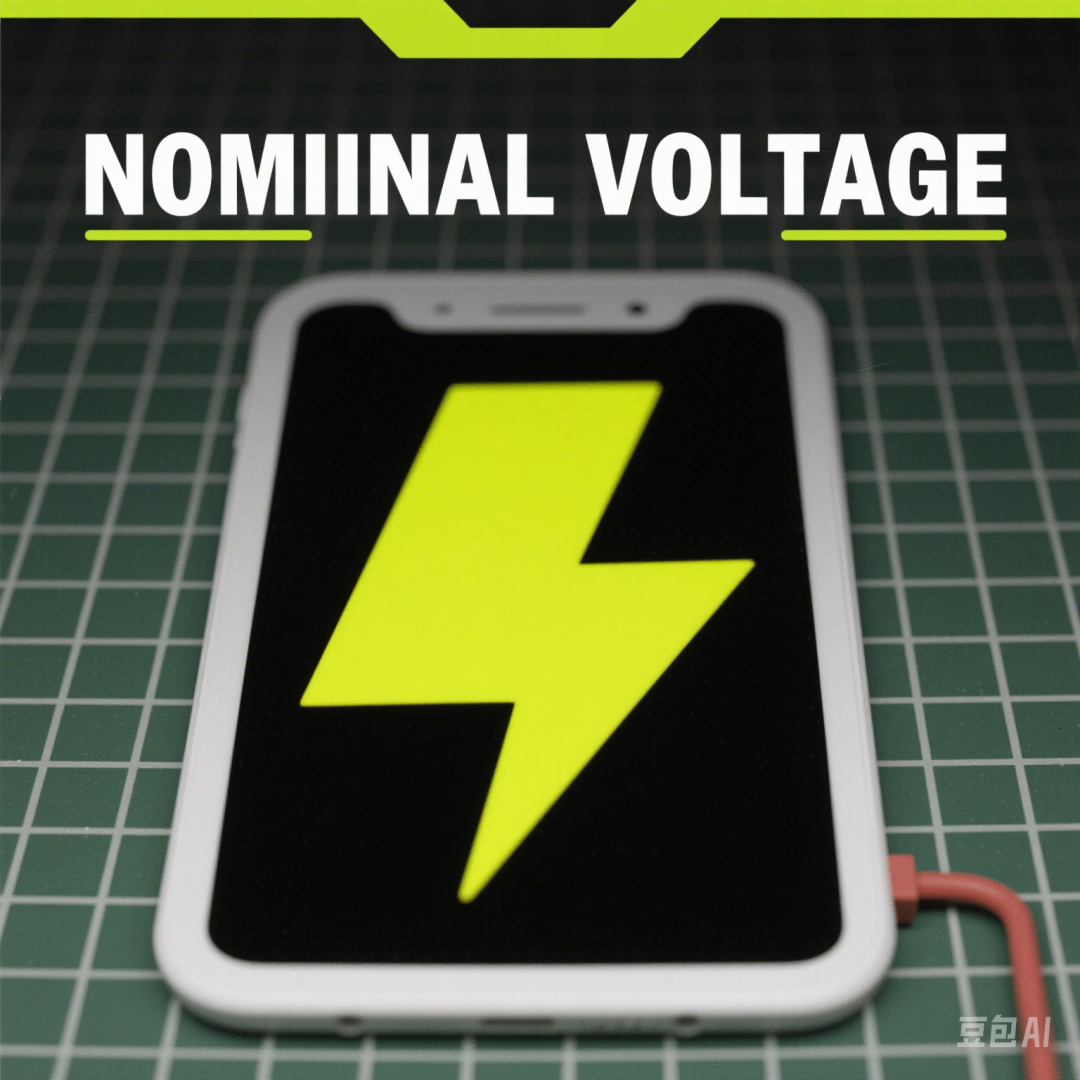
Nominal voltage is determined based on factors such as the battery’s electrochemical system and application scenarios, representing the average voltage level of the battery under normal usage conditions. For example, the nominal voltage of common alkaline dry batteries is 1.5V, while the nominal voltage of a single lithium-ion cell is typically around 3.6V – 3.7V. This value is theoretical; the actual voltage of the battery may fluctuate under different charging and discharging states and load conditions.
Understanding nominal voltage helps in correctly matching batteries with electronic devices. Choosing a battery with the appropriate voltage ensures that devices start and operate normally, avoiding issues caused by voltage mismatches that could lead to device failure or damage. In battery production, sales, and usage instructions, nominal voltage is an important reference indicator that helps users quickly identify the basic electrical characteristics of the battery.
O
Overcharge/Overdischarge Protection
Overcharging and over-discharging can severely damage batteries. The overcharge protection mechanism cuts off the power supply when the battery reaches the charging cut-off voltage, while over-discharge protection interrupts the discharge circuit when the battery voltage drops to the discharge cut-off voltage. They act as the “guardians of safety” for the battery, protecting its health, extending its lifespan, and preventing failures due to human negligence or equipment malfunctions.
P
Power Density
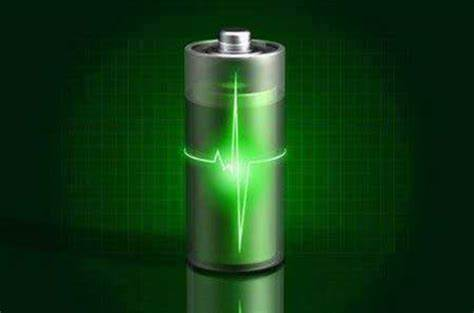
Power Density reflects the ability of a battery to release energy in a short period, measured in W/kg. For devices like power tools that require instantaneous high power output, batteries with high power density can easily meet the demands, allowing drills to spin quickly and saws to cut powerfully, ensuring that devices can deliver strong power at critical moments without hesitation.
R
Rated Energy
Rated Energy is the amount of energy that a battery can provide under standard conditions. It is a key parameter that reflects the battery’s capacity and voltage, and it has significant implications for the battery’s usage and transportation. It is typically used to describe the comprehensive performance of a battery in terms of capacity and voltage. The unit of rated energy is watt-hours (Wh), calculated using the formula:
Rated Energy (Wh) = Battery Capacity (Ah) × Nominal Voltage (V)
Importance and Applications
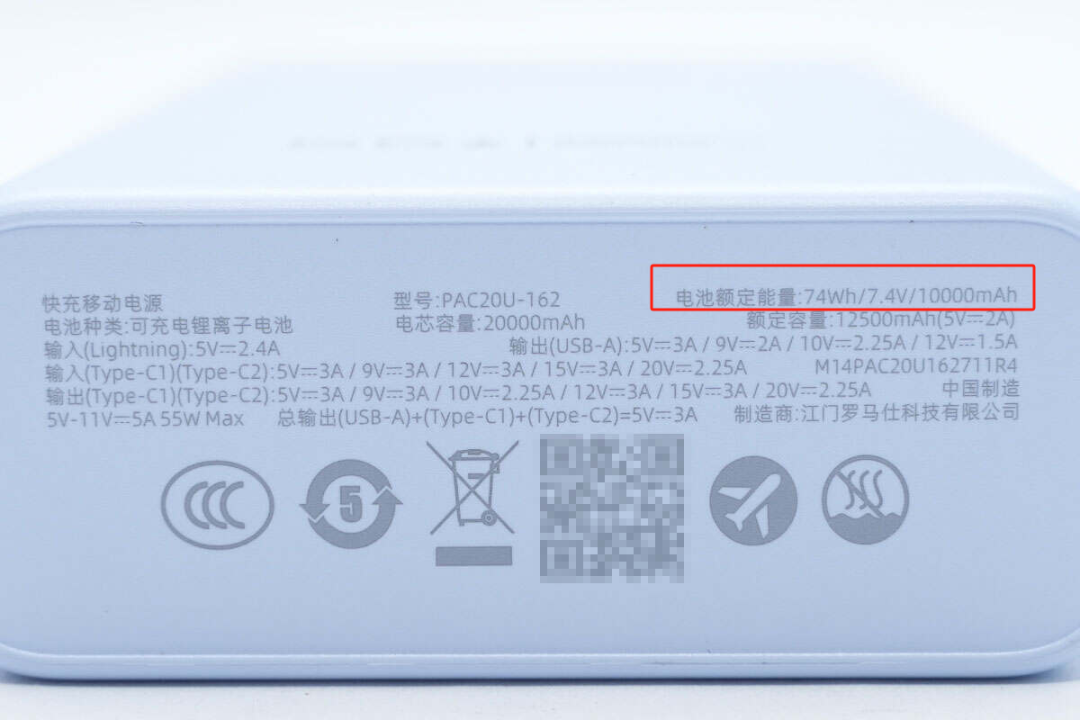
Device Compatibility: Rated energy helps users and engineers select batteries suitable for specific devices. For example, laptops, smartphones, and tablets require batteries with different rated energies to meet their operational needs.
Aviation Transport: In aviation transport, rated energy is an important indicator for lithium-ion and lithium polymer batteries. According to the International Air Transport Association (IATA), batteries with different rated energies have different transport requirements:
Rated Energy ≤ 100Wh: Generally allowed without airline approval; 100Wh < Rated Energy ≤ 160Wh: Requires airline approval to carry; Rated Energy > 160Wh: Prohibited from carrying.
S
SOC
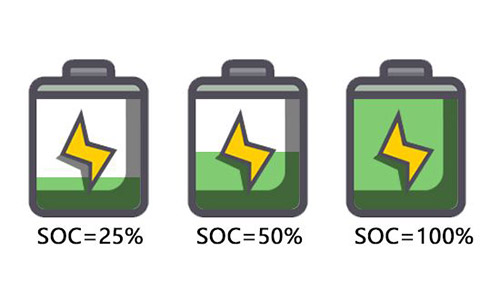
SOC (State of Charge) refers to the percentage of remaining battery capacity (0 – 100%), visually presenting the current energy available in the battery. The battery level icon commonly seen on smartphones displays the SOC, allowing users to know at a glance whether the battery has sufficient charge, facilitating timely charging arrangements to ensure continuous device usage.
Self-Discharge Rate
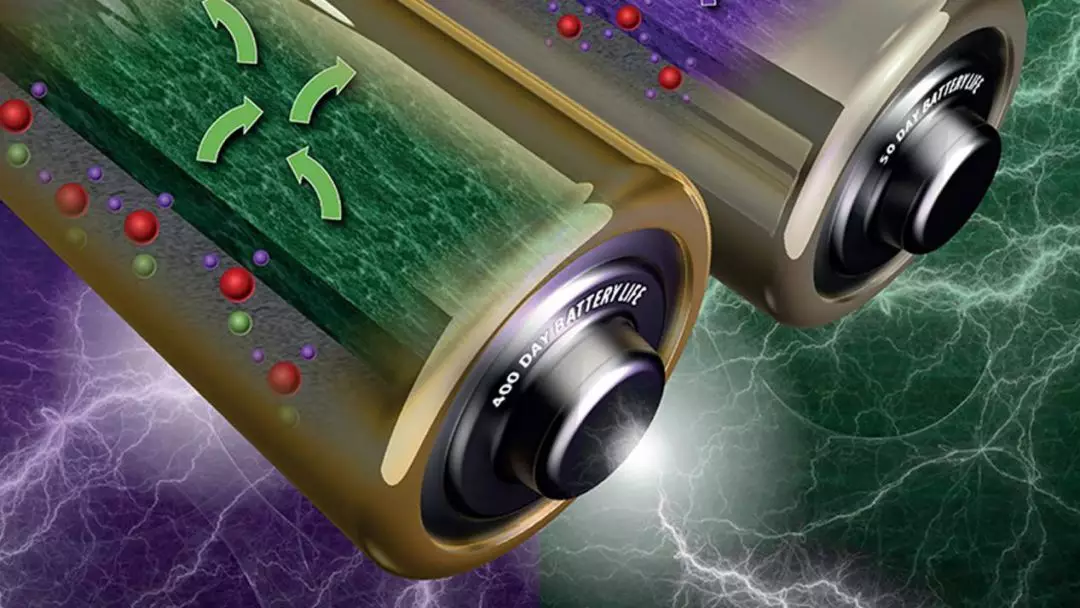
Self-Discharge Rate refers to the rate at which a battery loses its stored charge under open-circuit conditions, described in %/month. It indicates the speed at which a battery loses its charge when not in use. For instance, a power bank that has been left unused for a long time will gradually lose its charge due to self-discharge. Batteries with low self-discharge rates can ensure that sufficient charge remains after long-term storage, alleviating concerns about devices running out of power before use.
Summary from the Battery Trading Network
From the intelligent management of BMS to the endurance competition of energy density, the “jargon” of the battery industry is not only technical terminology but also a barometer of industry development. With breakthroughs in technologies such as fast charging and solid-state batteries, the meanings of these terms are constantly evolving. Understanding them can help you choose the right battery and gain insights into future energy trends. The next time you hear terms like “SEI film” or “power density,” don’t be confused—you are already a “king of understanding” in the battery world!
Related Reading1、Decoding the Battery Industry: Revealing 8 Terms of Industry Jargon